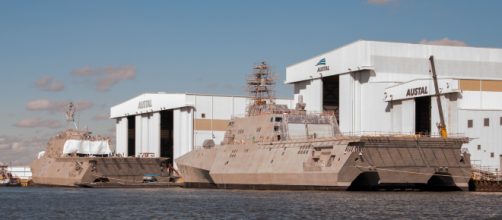The US Navy is charting a course to acquire a more effective anti-ship missile as a way to meet the growing threats posed by archrivals Russia and China. If deployed, this new anti-ship missile could greatly enhance the effectiveness of the US Navy’s weapons, allowing the Navy to hit its targets more precisely and from a much farther distance.
As mentioned earlier by the Asia Times, the US Navy’s newest anti-ship missile can travel more than 100 nautical miles, which is more than 30 miles over the range of the current anti-ship missile in the US Navy’s inventory, the Boeing Harpoon.
The subsonic Naval Strike Missile is the latest addition to the US Navy’s arsenal, and it is reportedly more capable than the current one. This new missile is expected to extend the Navy’s kill zone by several miles, enhancing the Navy’s warfighting capabilities.
The Navy’s new LCS is heading toward the South China Sea
The US Navy’s Independent-class littoral combat ship Gabrielle Gifford is now armed with the new Naval Strike Missile and is heading toward China’s backyard, the South China Sea. The Gabrielle Giffords is the ninth littoral combat ship to enter the service and the fifth Independent-class littoral combat ship (LCS) to join the fleet. The ship is the second LCS to deploy this year and now the Navy is sending it to Asia.
According to the Asia Times, US Navy Pacific Fleet spokesman Capt. John Gay already confirmed Giffords’ deployment in the region, who said the new littoral ship was deployed on September 3. He also added that the new ship was equipped with the Naval Strike Missile and the MQ-8C Fire Scout drone, a mission capable, over-the-horizon surveillance and targeting platform. A Navy official also confirmed that the new ship will be deployed to the Indo-Pacific area, along with sister ship LCS Montgomery, which is currently operating in the Gulf of Thailand, the website reported.
The deployment of the Gabrielle Giffords, along with the new Naval Strike Missile is the latest sign that the US Navy is gradually flexing its muscles in the vast Pacific Ocean, which during the past few months has seen rising tension over Chinese militarization and maritime claims.
But the US Navy is not backing down. Under the Donald Trump administration, the US Navy has stepped up to contain the Chinese’s hegemony, and increase its freedom-of-navigation patrols of Chinese claims in the South China Sea.
About the new Naval Strike Missile
Originally developed by the Norwegian-based Kongsberg Defense System, the Naval Strike Missile is an anti-ship and land-attack missile that features sophisticated stealth capabilities. This 900-pound, 3.95-meter missile is designed for littoral water and blue water scenarios. Like the other advanced anti-ship missiles, the NSM also travels in sea skim mode during its final approach on targets, according to Naval Recognition.
This new missile navigates to the target area using a combination of an inertial navigation system, terrain navigation, and GPS.
The INS provides an effective navigation system backup in case the adversary managed to disrupt the GPS communication link between the missile and the ship’s fire control. During the terminal stage of the missile’s flight, the NSM automatically switches to an infrared imaging seeker to find and destroy its target.
The NSM uses a target selection technology (a built-in database of representative ship types) along with the infrared imaging technology to discriminate between the intended target and other objects. The NSM relies on its stealthy characteristics to make it more difficult for enemies to track in radar and can also make a random movement to help avoid countermeasures during the critical terminal stage of its flight.
The Naval Strike Missile was first tested aboard the littoral combat ship Coronado in 2014. After a series of successful tests, the Norwegian firm Kongsberg and US firm Raytheon have teamed up to build the Navy's next anti-ship missile. In 2017, the Navy finally pulled out the much improved, extended-range Boeing RGM-84 Harpoon and the Lockheed Martin LRASM from the service’s Over-the-Horizon Weapon System competition. This makes the Kongsberg/Raytheon NSM the sole contender in the Navy’s anti-ship missile effort. Check out the video below to learn more about this new Navy anti-ship missile.


